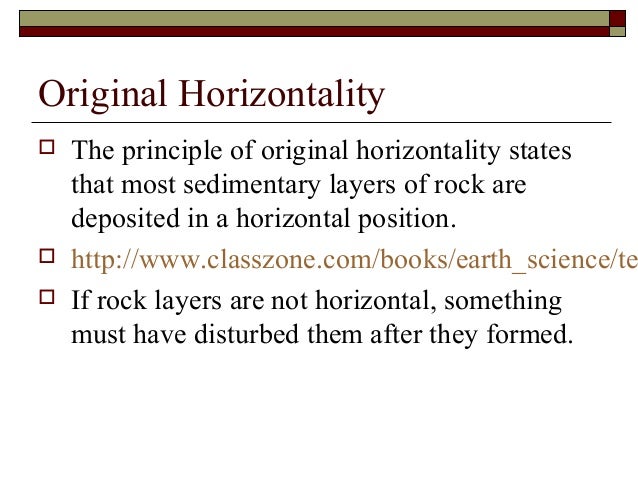

Therefore if horizontal strata are dissected by erosional features, such as a valley, they can be interpreted to be the same strata. Principle of original horizontality states that 'beds of sedimentary rocks formed as horizontal or horizontal layers'. Sediments are deposited laterally in continuous layers. See Original Horizontality and Superposition. Therefore, if rocks are tilted, folded or metamorphosed, then these events must have followed deposition and lithification. Sediments deposited or precipitated on the Earth’s surface accumulate in horizontal layers. Therefore the principle of uniformitarianism is expressed as “the present is the key to the past” which guides the principles of stratigraphy. 11: Geologic History 11. For example, the processes that transport and deposit sediment in a river are the same today as they were a billion years ago. Natural processes such as erosion and deposition, plate tectonics and the laws of gravity and isostasy produce the features of the Earth. Hutton realized the events in the earths past can be understood by observing the processes seen today. The principle of original horizontality departs from the assumption that most of the sedimentary rocks are deposited under the action of gravity, in. The principle of uniformitarianism was first stated by James Hutton in the 18th century. To determine the sequence of geologic events, several principles must be followed. The sequence orders the events but provides no information to the amount of time passed or between events. It is a qualitative way of describing the sequence of events. Placing of events in the order in which they occurred without any relationship to the actual time during which any one event occurred is known as relative dating. gneiss and fault A are cut by the igneous granitic intrusion called batholith B. Horizontal Strata/Beds.Cindy Kearns and Elizabeth Johnson Relative Dating The principle of original horizontality indicates that sediments are. East is to the right, south is at the bottom, and west is to the left. The “N” arrow indicates the North direction on this diagram.

It shows what the surface of the Earth above these rocks looks like, as though we were looking down from space. You can rotate this view in the 3D model to better see the arrow.įigure 1B is the map view of the block diagram from Figure 1A. We do not specify which types of rocks form the layers in these cartoon diagrams. In a real cross section or geologic map, each layer is color coded to be a specific type of rock. The different colors represent layers or beds of different types of rock. The Safari browser is NOT compatible with the 3D models.įigure 1A is a block diagram of horizontal layers or strata. The observation that sediment is deposited in essentially flat layers led to: a) the principle of cross-cutting relations b) the principle of lateral continuity c) the principle of original horizontality d) the principle of superposition e) the principle of uniformity, 2. To view block diagrams, you will need to use a compatible brower. Study with Quizlet and memorize flashcards containing terms like 1.

Principle of superposition Question and answer 8. The Principle of Original Horizontality states: Layers of rocks deposited from above, such as sediments and lava flows, are originally laid down horizontally. Which geological principle accounts for the tilting of the layers in the sedimentary rock shown in the image A. The Principle of Superposition states : In an otherwise undisturbed sequence of sedimentary strata, or rock layers, the layers on the bottom are the oldest and layers above them are younger. Stratigraphy is the study of layered sedimentary rocks. In order to understand the structural diagrams we will use in this module, it is necessary to remember two principles of stratigraphy. 26 Original Horizontality and Superposition


 0 kommentar(er)
0 kommentar(er)
